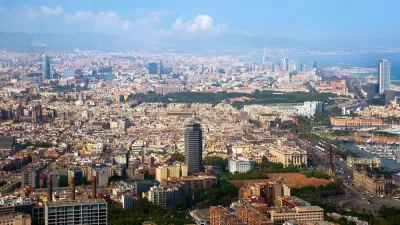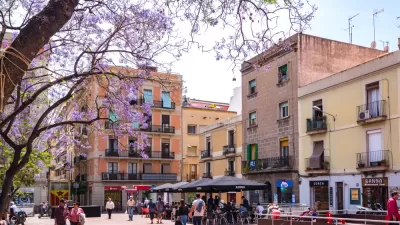Two weeks ago, after nearly two decades of waiting, Barcelona urban designer Salvador Rueda finally saw the first "Superilla" (Superblock) installed in the city. The superblock faced fierce opposition from unhappy residents and local businesses.
Rueda, who has led the Urban Ecology Agency of Barcelona since the year 2000, envisioned the superblock in 2002 when he was reorganizing the city’s old bus routes, a legacy of the industrial era. (See previous post: Superblocks, Barcelona Answer to Car-Centric City.)
A Superblock, according to Rueda, is defined by a grid of nine blocks where the main mobility happens on the roads around the outside of the Superblock, and the roads within are only for local use. The one-way system inside the Superblock makes it impossible to cut through to the other side, while still giving neighbours access to their garages and parking spaces. So the Superblock remains free of through traffic.
Superblocks are already at work in several cities in Spain, but Barcelona could be their best iteration because of the grid pattern of the Eixample, a broad swath of the city designed by Idelfons Cerdà back in the 1850s when Barcelona was rapidly expanding.
Last week’s official presentation of the first superblock in the Poble Nou neighborhood faced some fierce opposition from unhappy residents and local businesses complaining about loss of curbside parking, changes in street direction, and the installation of the superblock itself right after the summer holidays and without prior warning, they claimed.
The superblocks project also faces opposition from within the city council. After the installation of the pilot, some council members from the opposition parties asked for it to be dismantled and any further superblocks to be put on hold. Mercedes Vidal, Barcelona's councilor of mobility, was critical of that attitude, pointing out that some of those same people had approved the mobility plan and superblocks project under a prior administration.
Maria Rubert, professor of urbanism at the Architecture School of the Universitat Politècnica de Catalunya · BarcelonaTech, agrees that the superblocks will increase the quality of life for those people living inside the block. But she wants the city to consider other solutions for residents on streets that carry most of the traffic, such as imposing a congestion charge for cars entering the city (similar to the one in London), reducing the number of lanes and limiting the speed on main thoroughfares that cross the city.
Unfortunately, Barcelona is very accommodating to cars, Rubert says. Being a small, compact city, makes it easy to move around in a private vehicle, with most trips taking less than 15 minutes. Some streets of Barcelona are being used as motorways, she adds. It is important to “calm” all the main streets of Barcelona and divert through traffic outside the city center. It is not right, she says, that some residents should enjoy the pedestrian areas in the superblocks while others face streets full of traffic, noise, and pollution.
FULL STORY: Barcelona’s first Superblock, Fighting the Power of Habit and Wavering Political Will

Alabama: Trump Terminates Settlements for Black Communities Harmed By Raw Sewage
Trump deemed the landmark civil rights agreement “illegal DEI and environmental justice policy.”

Study: Maui’s Plan to Convert Vacation Rentals to Long-Term Housing Could Cause Nearly $1 Billion Economic Loss
The plan would reduce visitor accommodation by 25% resulting in 1,900 jobs lost.

Planetizen Federal Action Tracker
A weekly monitor of how Trump’s orders and actions are impacting planners and planning in America.

Grand Rapids Mayor Proposes Garage Conversion Plan
The mayor says allowing homeowners to convert garages to dwelling units could alleviate the city’s housing shortage.

Baltimore Ordered to Improve Sidewalk Accessibility
The city is one of many to face lawsuits for failing to comply with the Americans with Disabilities Act.

This Toronto Suburb Has More Bus Riders Than Columbus, Ohio
Brampton, Ontario used gradual improvements in service to prove that if you build it, they will ride.
Urban Design for Planners 1: Software Tools
This six-course series explores essential urban design concepts using open source software and equips planners with the tools they need to participate fully in the urban design process.
Planning for Universal Design
Learn the tools for implementing Universal Design in planning regulations.
Smith Gee Studio
Alamo Area Metropolitan Planning Organization
City of Santa Clarita
Institute for Housing and Urban Development Studies (IHS)
City of Grandview
Harvard GSD Executive Education
Toledo-Lucas County Plan Commissions
Salt Lake City
NYU Wagner Graduate School of Public Service




























